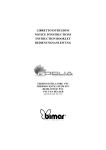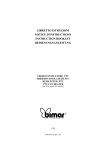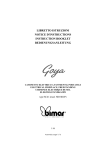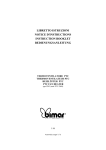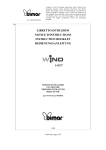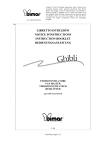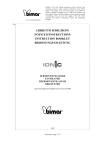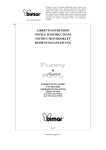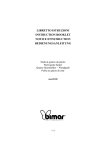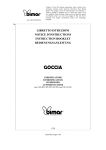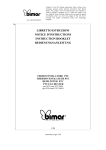Download Bimar S244.EU space heater
Transcript
LIBRETTO ISTRUZIONI NOTICE D'INSTRUCTIONS INSTRUCTION BOOKLET BEDIENUNGSANLEITUNG TERMOVENTILATORE PTC THERMOVENTILATEUR PTC HEIZLÜFTER PTC PTC FAN HEATER type S244 (mod. HT-50LED) 1/16 1. 2. 3. 4. 5. 6. 7. 8. 9. 10. Commandes électroniques Ecran LVD Grille de protection Télécommande Touche On/Off Touche vittesses ” ” et “ ” Touche température ambiante réglable Touche oscillation droite et gauche Touche timer Interrupteur 0/I 2/16 1. 2. 3. 4. 5. 6. 7. 8. 9. 10. Pannello comandi Display Griglia di protezione Telecomando Tasto on/off Tasto funzioni ” ” e “ ” Tasto temperatura ambiente regolabile Tasto oscillazione destra/sinistra Tasto timer Interruttore 0/I 1. 2. 3. 4. 5. 6. 7. 8. 9. 10. Control panel Display LCD Protection grid Remote control Button on/off Button function ” ” and “ ” Button adjustable room temperature Button oscillation right/left Button timer Switch 0/I 1. 2. 3. 4. 5. 6. 7. 8. 9. 10. Elektronisches Bedienfeld LVD-Display Schutzgitter Fernsteuerung Taste On/Off Taste Geschwindigkeiten ” ” und “ ” Taste regulierung der Raumtemperatur Taste oszillierend rechts – links Taste timer EIN/AUS Scha AVVERTENZE Questo simbolo vi invita a leggere attentamente queste istruzioni prima dell’uso dell’apparecchio, ed eventualmente informare terzi, se necessario. CONSERVARE IL LIBRETTO PER ULTERIORI CONSULTAZIONI. Questo simbolo vi invita a prestare attenzione, ed a leggere gli specifici avvertimenti sul libretto istruzioni. Questo apparecchio è destinato solo al riscaldamento di ambienti interni domestici e similari, secondo le modalità indicate in queste istruzioni. L’apparecchio non deve essere utilizzato in ambienti polverosi o con materiali estremamente volatili (potrebbero ostruire griglie o scambiatiore di calore), o in ambienti con elevata umidità, o con prodotti infiammabili, o in ambienti esterni (all’aperto). E’ da considerarsi inoltre apparecchio supplementare di riscaldamento, e non come impianto di riscaldamento centrale. Ogni altro uso è da considerarsi improprio e pericoloso. Il costruttore non potrà essere ritenuto responsabile di eventuali danni derivanti da uso improprio, erroneo e irresponsabile e/o da riparazioni effettuate da personale non qualificato. Quando il termoventilatore è in funzione si scalda, quindi toccare soltanto tasti e maniglia posteriore in plastica. Evitare il contatto con la griglia frontale perchè molto calda. Non inserire le dita e/o nessun oggetto attraverso le griglie (fronte o retro), per evitare abrasioni, scosse elettriche, o danni all’apparecchio. Controllate che il termoventilatore non venga in contatto con l’acqua o altri liquidi. Nel caso dovesse succedere non immergere la mano nel liquido ma per prima cosa togliere la spina dalla presa di corrente. Asciugare con cura l’apparecchio e verificare che tutte le parti elettriche siano asciutte: in caso di dubbio rivolgersi a personale professionalmente qualificato. In caso di caduta o cattivo funzionamento, scollegare immediatamente il cordone elettrico. Verificare che nessuna parte sia danneggiata, e dopo questi accertamenti accenderlo: in caso di dubbio rivolgersi a personale professionalmente qualificato. Non utilizzare l’apparecchio per asciugare indumenti. Non toccare l’apparecchio con mani o piedi bagnati. L’apparecchio non è destinato a essere usato da persone (bambini compresi) le cui capacità fisiche, sensoriali o mentali siano ridotte, oppure con mancanza di esperienza o di conoscenza, a meno che esse abbiano potuto beneficiare, attraverso l’intermediazione di una persona responsabile della loro sicurezza, di una sorveglianza o di istruzioni riguardanti l’uso dell’apparecchio. I bambini devono essere sorvegliati per sincerarsi che non giochino con l’apparecchio. L’apparecchio deve essere mantenuto fuori dalla portata di bambini. Attenzione: quando si utilizzano apparecchi elettrici, occorre sempre rispettare le precauzioni di sicurezza di base per evitare i rischi di incendio, di scosse elettriche e di lesioni fisiche. La griglia di protezione non fornisce completa protezione a bambini o a persone con ridotte capacità fisiche, sensoriali o mentali. Non spostare l’apparecchio quando è in funzione. L'utilizzatore non deve lasciare l’apparecchio senza sorveglianza quando è collegato all'alimentazione. Se l’apparecchio non è in funzione togliere la spina dalla presa di corrente e anche se non è utilizzato per pochi istanti. Al fine di evitare ogni rischio di scossa elettrica, non immergere mai la spina, il cordone elettrico e l’apparecchio nell’acqua od in nessun altro liquido. Non lasciare l’apparecchio esposto agli agenti atmosferici (sole, pioggia, ecc.). Non tirare il cavo di alimentazione o l’apparecchio stesso per disinserire la spina dalla presa di corrente. 3/16 Non usare l’apparecchio se non funziona correttamente o se sembra danneggiato; in caso di dubbio rivolgersi a personale professionalmente qualificato. Se il cavo di alimentazione è danneggiato, deve essere sostituito dal costruttore o dal suo servizio assistenza tecnica o comunque da una persona con qualifica similare, in modo da prevenire ogni rischio. Questo simbolo indica: ATTENZIONE: per evitare il surriscaldamento non coprire l’apparecchio. INSTALLAZIONE Dopo aver tolto l’imballaggio, assicurarsi dell’integrità dell’apparecchio; in caso di dubbio non utilizzarlo e rivolgersi a personale professionalmente qualificato. Gli elementi di imballaggio (sacchetti in plastica, polistirolo espanso, chiodi, ecc.) non devono essere lasciati alla portata di mano di bambini in quanto potenziali fonti di pericolo; smaltirli secondo le norme vigenti Prima di collegare l’apparecchio controllare che i valori di tensione riportati sulla targa dati corrispondano a quelli della rete elettrica. Verificare che sulla linea elettrica non siano collegati altri apparecchi ad elevato assorbimento, per evitare sovraccarichi e rischi di incendio. In caso di incompatibilità tra la presa e la spina dell’apparecchio, far sostituire la presa con altra di tipo adatto da personale professionalmente qualificato, il quale accerti che la sezione dei cavi della presa sia idonea alla potenza assorbita dall’apparecchio (10A). In generale è sconsigliato l’uso di adattatori e/o prolunghe; se il loro uso si rendesse indispensabile, devono essere conformi alle vigenti norme di sicurezza e la loro portata di corrente (ampères) non deve essere inferiore a quella massima dell’apparecchio. Attenzione: eventuali adesivi, talloncini o fogli pubblicitari devono essere rimossi prima dell’uso dell’apparecchio. La presa di corrente deve essere facilmente accessibile in modo da poter disinserire con facilità la spina in caso di emergenza. Posizionare il termoventilatore lontano da altre fonti di calore, da materiali infiammabili (tende, tappezzerie, ecc.), da gas infiammabili o materiale esplosivo (bombolette spray) e da materiali che possono deformarsi con il calore. Verificare che lo spazio libero sia di 120 cm dalla parte frontale e laterale del termoventilatore e 100 cm sul retro. Non utilizzare questo apparecchio nelle immediate vicinanze di una vasca da bagno, di una doccia o di una piscina, (per evitare che gocce d’acqua possono cadere sull’apparecchio e che lo stesso possono cadere in acqua), e che lo stesso possono cadere in acqua: qualora dovesse accadere non immergere la mano ma per prima cosa togliere la spina dalla presa di corrente: asciugare con cura prima di riaccenderlo ed in caso di dubbio farlo controllare a personale professionalmente qualificato. L’apparecchio non deve essere posizionato immediatamente al di sotto di una presa di corrente. Non appendere o semplicemente accostare l’apparecchio al muro o pareti. Assicurarsi che il cavo sia posizionato correttamente e che non sia a contatto con parti calde o spigoli taglienti, né avvolto intorno all’apparecchio o attorcigliato su se stesso e non si impigli, onde evitare una caduta dell’apparecchio. Verificare che non vi si possa inciampare, per evitare cadute accidentali o danni alle persone. Verificare inoltre che il cordone non sia al di sotto di tappeti. La superficie d’appoggio deve essere stabile, ampia (sono da escludere mensole), solida, resistente al calore e ignifuga, non in pendenza (in quanto l’apparecchio potrebbe ribaltarsi), e priva di asperità perché la base possa poggiare correttamente l’apparecchio sia perfettamente verticale, altrimenti il dispositivo anti-ribaltamento interrompe tutte le funzioni. Assicurarsi che le ventole funzionino correttamente: nel caso contrario spegnere l’apparecchio e farlo controllare da personale professionalmente qualificato. Assicurarsi che l’elemento riscaldante sia libero da polvere, lanugine, o quant’altro simile: migliora la resa del termoventilatore, e si impedisce il surriscaldamento dell’apparecchio. Verificare 4/16 periodicamente la che la griglia di aspirazione non venga ostruita da oggetti, tessuti o altro per evitare il surriscaldamento o la rottura dell’apparecchio. Questo apparecchio non è destinato a essere fatto funzionare per mezzo di un temporizzatore esterno o con un sistema di comando a distanza separato, per evitare il rischio di incendio nel caso l’apparecchio sia coperto o sia posizionato in modo non corretto. Controllare che sulla stessa linea elettrica non siano collegati altri apparecchi ad alto assorbimento. In caso di guasto o cattivo funzionamento spegnere l’apparecchio e farlo controllare da personale professionalmente qualificato. ISTRUZIONI DI IMPIEGO Prima di ogni utilizzo verificare che l’apparecchio sia in buono stato, che il cordone elettrico non sia danneggiato: se il cavo di alimentazione è danneggiato, esso deve sostituito dal costruttore o dal suo servizio assistenza tecnica o comunque da una persona con qualifica similare, in modo da prevenire ogni rischio. Il termoventilatore può essere impiegato per la sola ventilazione o per riscaldare; è dotato di resistenza in ceramica ad alta efficienza, che da sé riduce l’assorbimento con l’aumentare della temperatura ambiente. E’ dotato dei seguenti elementi di regolazione, cui si agisce premendo la tastiera del pannello comandi o con quella del telecomando. Il telecomando deve essere puntato in direzione del display adiacente agli interruttori, e prima ancora inserirvi le batterie (aprire lo sportello posteriore e inserire 2 batterie tipo “AAA” rispettando la polarità; richiudere lo sportello). Nel dettaglio le regolazioni sono: l’interruttore principale (10). Tasto accensione (5) “ ” per accendere l’apparecchio - - Tasto di regolazione della potenza (6) “ ” si regola la potenza desiderata, spia corrispondente “ “=aria calda; spia corrispondente “ “ =aria molto calda Tasto per la temperatura ambiente regolabile (7) “ “: mantiene costante la temperatura ambiente al valore impostato. La gamma di temperatura è compresa fra 4-32°C, si regola premendo il tasto “+” oppure “-“ per aumentare o diminuire la temperatura che il display visualizza durante questa operazione Tasto oscillazione (8) “ “ destra/sinistra (cioè rotazione, alternativamente a destra e sinistra) Tasto per la regolazione del tempo di funzionamento (9) “ “, questa funzione consente di impostare il tempo di funzionamento, al termine del quale l’apparecchio si arresta automaticamente. Per eliminare il movimento premere il tasto fino a che sul display appare “0h”. Per l’impiego del termoventilatore si operi nel modo seguente: 1. Inserire la spina nella presa di corrente. 2. Accendere l’interruttore principale (pos.”I”): la spia rossa sul display si accende, segnalando la presenza di tensione. 3. Accendere l’interruttore “ ” (della tastiera o del telecomando), e la funzione aria molto calda si avvia “ ”. - 4. 5. Selezionare la funzione desiderata, premendo il tasto “ ” (della tastiera o del telecomando), ad ogni pressione del tasto sul display si illumina la funzione desiderata: spia corrispondente “ “=aria calda (circa 900W); spia corrispondente “ “ =aria molto calda (circa 1800W). Temperatura ambiente: mantiene costante la temperatura ambiente al valore impostato. La gamma di temperatura è compresa fra 4-32°C e si seleziona dal pannello comandi o dal telecomando, premendo il tasto “ ”, e premendo il tasto “+” oppure “-“ per aumentare o diminuire la temperatura che il display visualizza durante questa operazione. Esempio: 5/16 6. 7. selezionando questa funzione sul display appare la temperatura ambiente della stanza, impostando 30°C, premere il tasto “+” per aumentare la temperatura desiderata, la temperatura impostata (30°C) lampeggerà per qualche secondo e poi sul display sarà visualizzata la temperatura ambiente della stanza, dopo un po’ di tempo la temperatura aumenta (sul display sarà visualizzata la temperatura effettiva) fino a 30°C. Raggiunta la temperatura selezionata (30°C) l’apparecchio funzionerà sempre, ma riduce l’assorbimento con l’aumentare della temperatura ambiente, cioè: bassa temperatura=massima potenza & alta temperatura=minima potenza). Per disattivare questa funzione, premere il tasto funzioni (6) o spegnere l’apparecchio tramite il tasto on/off. Se si desidera la funzione di oscillazione, premere il pulsante “ “ (della tastiera o del telecomando). Per disattivare questa funzione premere nuovamente il tasto. Timer: questa funzione consente di impostare il tempo di funzionamento, al termine del quale l’apparecchio si arresta automaticamente. Per impostare il tempo di funzionamento, premere ripetutamente il tasto “ “ del telecomando o del pannello comandi: ad ogni pressione del tasto varia il tempo impostato, e sul display apparirà il tempo selezionato ( 1 ora - 2 ore ….8 ore): il tempo massimo è di 8 ore. Per disattivare il timer, premere il tasto “ “, fino a che sul display apparirà “0h”. 8. Per spegnere completamente l’apparecchio premere l’interruttore “ ” (della tastiera o del telecomando). Per lunghi periodi di inattività, togliere la spina dalla presa di corrente. Nel caso di urto accidentale con conseguente ribaltamento, il dispositivo di sicurezza spegne l’apparecchio: riposizionare il termoventilatore correttamente, riaccendere l’apparecchio tramite il pannello comandi o del telecomando. PULIZIA E MANUTENZIONE Attenzione: prima di pulire l’apparecchio spegnerlo, disinserire la spina dalla presa di corrente ed attendere che si sia raffreddato Assicurarsi periodicamente che la griglia di aspirazione posteriore non risulti ostruita da lanugine o sfilacci: nel caso rimuoverla con uno spazzolino o un’aspirapolvere, facendo attenzione a non danneggiare alcuna parte. Per la pulizia del corpo utilizzare un panno morbido leggermente umido; non utilizzare pagliette metalliche o prodotti abrasivi. Per lunghi periodi di inattività del termoventilatore, è necessario coprirlo e riporlo in un luogo asciutto; è consigliabile inserirlo nell’imballo originale per proteggerlo dalla polvere e dall’umidità. Per la sostituzione del cordone elettrico necessita un utensile speciale: rivolgersi ad un centro assistenza autorizzato anche per eventuali riparazioni. Se si decide di non utilizzare più l’apparecchio, si raccomanda di renderlo inoperante tagliando il cavo di alimentazione (prima assicurarsi d’aver tolto la spina dalla presa di corrente), e di rendere innocue quelle parti che sono pericolose qualora utilizzate per gioco dai bambini. Non disperdere nell’ambiente prodotti non biodegradabili, ma smaltirli nel rispetto delle norme vigenti. Alla fine della sua vita utile il prodotto non deve essere smaltito insieme ai rifiuti urbani. Può essere consegnato presso gli appositi centri di raccolta differenziata predisposti dalle amministrazioni comunali, oppure presso i rivenditori che forniranno questo servizio all’acquisto di una nuovo apparecchio. Smaltire separatamente un elettrodomestico consente di evitare possibili conseguenze negative per l’ambiente e per la salute derivanti da un suo smaltimento inadeguato e permette di recuperare i materiali di cui è composto al fine di ottenere un importante risparmio di energia e risorse. Per rimarcare l’obbligo di smaltire separatamente gli elettrodomestici, sul prodotto è riportato il marchio del contenitore di spazzatura mobile barrato. Si tenga presente che: il corpo, ventola e 6/16 coperchio sono in plastica; I conduttori elettrici sono in rame rivestito in gomma. - Il motorino elettrico è composto da ferro e rame. La resistenza elettrica è composta da ceramica e ferro. Please read these instructions carefully before using the appliance, and instruct other persons using it, too, when necessary. KEEP BOOKLET HANDY FOR FURTHER USE. GENERAL ADVISE This appliance is destined only to the heating of domestic or similar environments and in compliance with these instructions. It can be considered only a supplementary source of heating and not as a central heating element. The appliance must not be used in dusty environments or in the presence of extremely volatile materials which could obstruct grids or heat exchanger, nor in very damp environments, in the presence of inflammable products, or out of doors in the open. Any other use is to be considered inappropriate and therefore dangerous. The manufacturer cannot be held responsible for eventual damage caused by inappropriate, improper or irresponsible use and/or for repairs made to the product by unauthorised personnel. The fan heater gets hot when working; so only touch the handle and plastic Knobs. Avoid contact with the heating element. Ensure that the heating fan does not come into contact with water or other liquids. If this should happen, never immerse hands in the liquid but remove the plug from the socket first of all. Dry the appliance carefully and check that all the electric parts are dry. If in doubt, call a qualified expert. If the appliance should fall over or shows signs of faulty operation, disconnect the electrical cable immediately. Check that no part is damaged and switch it on after the appliance has been thoroughly checked: in case of doubt, contact qualified professional personnel. This appliance is not intended for use by persons (including children) with reduced physical, sensory or mental capabilities, or lack of experience and knowledge, unless they have been given supervision or instruction concerning use of the appliance by a person responsible for their safety. Children should be supervised to ensure that they do not play with the appliance. The appliance must be kept out of children’s reach. Attention: when using electric appliances, the basic safety precautions must always be observed to avoid risks of fire, electric shocks and physical injury. Do not move the appliance when it is in function. Do not use the appliance if it is not operating correctly or seems damaged; if in doubt, contact professionally qualified personnel. Unplug the appliance when not in use. The fireguard of this heater is intended to prevent direct access to heating elements and must be in place when the heater is in use, but the fireguard does not give full protection for young children and for infirm person. That the user must not leave the appliance unattended while it is connected to the supply. Do not touch the heater with wet hands or feet. Never use the radiator to dry damp garments. Do not expose the heater to the weather (sun, rain, etc.). Do not pull on the power cord or the appliance to unplug the appliance from the wall socket. Never move the appliance by pulling the cord. If the electric cord is damaged, it has to be replaced by the supplier or an authorized service center or a professionally qualified, to avoid any risks. 7/16 This symbol show: ATTENTION do not cover the appliance when it is operating to avoid the risk of fires. INSTALLATION After removing the packing materials, check the integrity of the heater; if you are unsure, do not use it and ask for qualified professional help. The packing materials (plastic bags, polystyrene foam, nails, etc.) must be kept out the reach of children because they are potential sources of danger. Before connecting the appliance, check that the voltage shown on the data plate matches that of your electricity (220-240V~ 50Hz). In the event of incompatibility between the electric outlet and the plug of the heater, have the outlet replaced with another more suitable type by professionally qualified personnel, who will make sure that the section of the wires of the outlet is appropriate for the absorbed power of the heater (10A). In general, the use of adapters or extension cords is not recommended; if their use is indispensable, they must conform to existing safety standards and their current capacity (amperes) must not be less that the maximum of the heater. Before each use, verify that the heater is in good condition and that the electrical cord is not damaged: in the case of doubt, ask for professionally qualified help. Don’t hang it on the wall. Make sure that the cable is correctly positioned and that it is not in contact with hot parts or sharp edges, nor wrapped around the device or twisted. The power socket must be easy to reach so the plug can be removed quickly in case of emergency. Position the fan heater far from other sources of heat, inflammable materials (curtains, carpets, etc.), inflammable gases or explosive materials (spray cans) and from materials that can deform on exposure to heat. Make sure that there is 120 cm of free space in front of the fan heater and 100 cm on the sides. Do not use this heater in the immediate surroundings of a bath, a shower or a swimming pool. (to avoid drops of water falling on the heater or the heater falling in the water), or in places where it could be subject to shocks. The support surface must be stable (exclude shelf) and not sloping (since the heater could tip over). Make sure that the n.2 air-intake grids is not obstructed by objects, fabrics or anything else to avoid the heater overheating or breaking. Do not use the appliance with a timer or a programmer or with a system that can switch on the appliance automatically, to avoid risk of fire, since a fire risk exists if the heater is covered or positioned incorrectly. Check that no other high absorption appliances are connected to the same power source. In the case of a breakdown or fault, switch off the appliance and have it checked by a professionally qualified technician; repairs made by unqualified persons can be dangerous and render void the warranty. OPERATION Before each use, verify that the unit is in good condition, the electric cord is not damaged, if the power cord is damaged, it must be replaced by the manufacturer or a competent qualified electrician or a person with similar qualifications, in order to avoid any risk. The fan heater is equipped with an on-off switch (5) “ ”, power regulator by pressing the switch (6) “ “ ”: (900W=light , and 1800W=light ), the room temperature by pressing the switch (7) “ can be adjusted between 4°-32°C; oscillation function by pressing the switch (8) “ “ (rotation alternatively right and left) and timer function (9) “ ”. The remote control must be directed towards the display next to the switches, after having inserted the batteries required (open the rear slot cover and insert 2 “AAA” type batteries, taking care to respect the correct polarity. Close the slot cover again). 8/16 For use, the fan heater operates as follows: 1. Insert the plug in the wall socket. 2. Switch on the main switch (pos.”I”): the led above the control panel will light up to show that the heater is connected to the main line. 3. Turn the “ ” switch (on the panel or the remote control), to start up the high function “ ”. 4. 5. 6. 7. Select the required function, by pressing the “ ” button several times (on the panel or the remote control); each time the button is pressed the display will light up the required function (900W=light and 1800W=light ), The room temperature: keeps room temperature constantly at the set value. Temperature range between 4°C and 32°C is selected from panel and remote control, press “ ” key, if pressing either the “+” or “-“ key to increase or reduce the temperature shown on the display at the time Example: if we want temperature at 30°C, you must select the “+” key until on the LED show 30°C, then the 30°C flash for some seconds, and then the LED show the effective temperature of the room temperature, then some time the temperature will increase and on the LED will show the room temperature updated until at 30°C. When on the LED will show 30°C, the appliance always function, but will decrease the out power. The appliance will start automatically to function when the temperature decrese on the room temperature. To obtain the oscillation function, press the “ “ button (on the panel or the remote control). To deactivate this function, press also the “ “ button. Timer: this function allows setting the operating time and the fan will automatically stop at the end. To set the operating time, repeatedly press the “ ” key on the remote control or the control panel: every time the key is pressed, the time set is changed and the indicator light on the control panel lights corresponding to the time selected (1 hour, 2 hours,… 8 hours): the maximum time is 8 hours. To deactivate the time, press the “ ” until on the display show “0h”. 8. When switching off the appliance, press the switch “ ” (on the panel or the remote control). When the appliance is not in use for long periods, remove the plug from the wall socket. If the fan heater is hit accidentally causing it to fall over, the safety security on the appliance will switch off the heater automatically: by replacing the heater in its correct position and reselect the function with the control panel or remote control. CLEANING AND MAINTENANCE Attention: before cleaning the fan heater, turn it off, remove the plug from the outlet and wait for it to cool. Periodically check that the air-intake grill is not obstructed by fuzz or threads. Use a soft, slightly damp cloth to clean the body; do not use metal scouring pads or abrasive products. For long periods of inactivity, you must cover it and place it in a dry place; it is advisable to put it in its original packaging to protect it from dust and humidity. A special tool is required to replace the electrical cord: contact an authorized service center, also for any repairs. If you decide not to use the fan heater, we recommend that you make it inoperative by cutting the power cord (but first make sure you have removed the plug from the electrical outlet), and make those parts harmless that are dangerous when played with by children. 9/16 Do not dispose of non-biodegradable products in the environment but dispose of them in accordance with current law. At the end of its working life, the product must not be disposed of as urban waste. It must be taken to a special local authority differentiated waste collection centre or to a dealer providing this service. Disposing of a household appliance separately avoids possible negative consequences for the environment and health deriving from inappropriate disposal and enables the constituent materials to be recovered to obtain significant savings in energy and resources. Bear in mind that: the casing, fan and cover are made of plastic; the electrical wires are copper coated in rubber. – The electric motor is made of iron and copper. The electrical resistance is made of ceramic material and iron. Nous vous prions de lire attentivement ces instructions avant d’utiliser l'appareil et de les divulguer à toutes les personnes qui pourraient en avoir besoin. GARDEZ-LES A PORTEE DE MAIN. RECOMMANDATIONS - Cet appareil est uniquement destiné au chauffage domestique et semblable et doit être utilisé conformément aux présentes instructions. Il s’agit d’un appareil de chauffage d'appoint, et non pas d’une installation de chauffage central. Ne pas l’utiliser dans des endroits poussiéreux ou en présence de matières extrêmement volatiles (qui pourraient obstruer les grilles ou l'échangeur de chaleur) ou dans des endroits très humides, en présence de produits inflammables ou à l'extérieur. Tout autre usage est considéré comme inopportun et donc dangereux. Aucune responsabilité ne peut être engagée pour des détériorations dues à une utilisation inappropriée ou non conforme au mode d’emploi et/ou pour des réparations faites par du personnel non autorisé. - Quand le thermoventilateur est en service, il se réchauffe et il faut par conséquent toucher seulement les poignée et bouton en matière plastique. Eviter le contact avec la partie chauffante. - S'assurer que le thermoventilateur n'entre pas en contact avec de l’eau ou d'autres liquides. Si cela devait arriver, ne pas plonger la main dans le liquide, mais commencer par enlever la fiche de la prise secteur. Sécher l’appareil avec soin et vérifier que toutes les parties électriques sont bien sèches : en cas de doute, s’adresser à un réparateur qualifié. Vérifier si le thermoventilateur n’est pas en contact avec de l’eau ou d’autres liquides. Si par mégarde il devait se baigner ou s’immerger dans le liquide, enlever immédiatement la fiche de la prise de courant, sécher soigneusement et vérifier que le liquide ne soit pas entré à l’intérieur ; en cas de doute, s’adresser au personnel professionnellement qualifié. - Ne pas toucher l’appareil avec les mains ou les pieds mouillés. - Ce produit n’est pas prévu pour être utilisé par des personnes (y compris les enfants) possédant des capacités physiques, sensorielles ou mentales réduites ou bien une expérience et connaissance insuffisante, à moins qu’elles ne se trouvent sous la surveillance de quelqu’un ou qu’elles n’aient reçu des instructions concernant l’utilisation de l’appareil de la part des personnes responsables de leur sécurité. Il convient de surveiller les enfants pour s’assurer qu’ils ne jouent pas avec l’appareil. 10/16 - Tenir hors de portée des enfants. - Attention: lorsque vous utilisez des appareils électriques, respectez toujours les consignes de sécurité élémentaires, afin d’éviter tout risque d'incendie, de décharge électrique ou de lésion corporelle. - Ne déplacez pas le l’appareil quand il est en train de fonctionner. - N'utilisez pas l’appareil s’il ne fonctionne pas correctement ou semble endommagé ; en cas de doute, adressez-vous à un technicien spécialisé. - La grille de protection n’est pas une protection fiable à 100 % pour les enfants ou les personnes ayant des capacités physiques, sensorielles ou mentales réduites. - Ne laissez jamais votre appareil sans surveillance lorsque celui-ci est sous tension. - Evitez d’utiliser le radiateur pour sécher le linge. - Ne laissez jamais votre appareil sans surveillance lorsque celui-ci est sous tension. - Ne pas laisser l’appareil exposé aux agents atmosphériques (soleil, pluie, etc.) - Ne pas tirer le câble d’alimentation ou l’appareil lui-même pour débrancher la fiche de la prise de courant. - Si le câble est endommagé, il doit être obligatoirement remplacé par un service qualifié compétent ou par une personne qualifiée. Ce symbole indique: ATTENTION ne couvrez pas l’appareil lorsque celui-ci est en fonctionnement afin d’éviter les risques d’incendie. INSTALLATION Après avoir enlevé l’emballage, s’assurer de l’intégrité de l’appareil; en cas de doute, ne pas l’utiliser et s’adresser à un personnel qualifié professionnellement. On ne doit pas laisser les éléments d’emballage (sachets en matière plastique, polystyrène expansé, clous, etc...) à portée de main des enfants étant donné que ce sont des sources de danger potentielles. Attention: enlever le coupon attaché à poignée avant d'utiliser l'appareill. Avant d'utiliser l'appareil, vérifiez que la tension du réseau corresponde bien à celle indiquée sur la plaque signalétique de l'appareil. En cas d'incompatibilité entre la prise et la fiche de l'appareil, faites remplacer le cordon d'alimentation par un service qualifié compétent qui devra s'assurer que la tension du cordon corresponde à la tension du réseau électrique (10A). En général l'utilisation d'adaptateurs ou de rallonges est déconseillée; cependant, s'il s'avère indispensable d'en utiliser, ils doivent être conformes aux normes de sécurité en vigueur et leur ampérage ne peut pas être inférieur au maximum de l'appareil. Avant chaque utilisation, vérifier si l’appareil est en bon état, si le cordon électrique n’est pas endommagé: en cas de doute, il faut s’adresser au personnel qualifié professionnellement. Il faut s’assurer que le câble est bien placé correctement et qu’il n’est pas en contact avec des parties chaudes ou des arêtes tranchantes, ni enroulé autour de l’appareil ou entortillé sur lui-même. La prise secteur doit être facile d’accès afin de pouvoir débrancher facilement l’appareil en cas d'urgence. Placer le thermoventilateur loin des autres sources de chaleur, loin des matériaux inflammables (rideaux, tapisseries, etc.), des gaz inflammables ou d’une matière explosive (petites bouteilles spray) et des matériaux qui peuvent se déformer avec la chaleur. Vérifier si l’espace libre est de 120 cm à partir de la partie frontale du thermoventilateur et de 100 cm à partir des côtés. Ne pas utiliser l’appareil dans le voisinage immédiat d’une baignoire, d’une douche ou d’une piscine (pour éviter que des gouttes d’eau ne tombent sur l’appareil qui peut lui-même tomber dans l’eau), ni dans des lieux où il puisse subir des chocs. Ne l'accrochez pas au mur. L’appareil ne doit jamais être positionné directement sous une prise électrique. La surface d’appui doit être stable (exclure l'étagère), pas inclinée (étant donné que l’appareil pourrait se renverser). Il faut s’assurer que l’hélice de ventilation fonctionne correctement: autrement, il faut éteindre l’appareil et le faire contrôler par un personnel qualifié professionnellement. S'assurer que la grille d'aspiration et l’élément chauffant sont exempts de poussière, de moutons ou autre : le rendement sera amélioré et l'appareil évitera de chauffer excessivement. Vérifier que la grille d'aspiration n'est pas obstruée par des objets, des tissus ou autre chose pour éviter la surchauffe ou l’endommagement de l'appareil. 11/16 Il faut s’assurer que la grilles d’aspiration ne puisse pas s’obstruer avec des objets, des tissus ou d’autres choses afin d’éviter la surchauffe ou la rupture de l’appareil. N'utilisez pas l'appareil avec une minuterie ou un programmateur ou avec un système qui peut mettre l'appareil en marche automatiquement, pour éviter tout risque d'incendie si l’appareil est couvert ou situé en position non appropriée. Contrôler qu'aucun autre appareil à haute absorption n'est branché sur la même ligne électrique. En cas de panne ou de mauvais fonctionnement, éteindre l’appareil et le faire contrôler par un personnel qualifié professionnellement. FONCTIONNEMENT Avant chaque utilisation, vérifiez que l'appareil est en bon état, le cordon électrique n'est pas endommagé, si le cordon d'alimentation est endommagé, il doit être remplacé par le fabricant ou son agent de service ou par une personne des qualifications semblables, afin d'éviter tout risque. Il faut pointer ce dernier en direction de l’écran d’affichage adjacent aux interrupteurs, et avant même d’insérer les batteries (ouvrir la portière postérieure et insérer 2 batteries de type « AAA » en respectant la polarité. Refermer la portière). Les règles sont, dans les détails : Le ventilateur de chauffage est équipé d'un interrupteur marche-arrêt (5), “ ”, régulateur de puissance en appuyant sur l'interrupteur (6) " ”: (900W = lumière, et 1800W = lumière), la température de la pièce en appuyant sur l'interrupteur “ “ peut être ajustée entre 4°-32°C; fonction oscillation en appuyant sur l'interrupteur “ “ (rotation alternativement à droite et à gauche). Pour l'utilisation, le ventilateur de chauffage fonctionne comme suit: 1) Insérer la fiche dans la prise murale. 2) Allumer l’interrupteur principal (Pos. « I »): le conduit au-dessus du panneau de commande s'allume pour indiquer que l'appareil est connecté à la ligne principale. 3) Mettez le “ ” switch (sur le panneau ou de la télécommande) pour lancer la fonction de haut . 4) Sélectionnez la fonction souhaitée en appuyant sur les bouton " " à plusieurs reprises (sur le panneau ou de la télécommande), chaque fois que le bouton est enfoncé, l'écran s'allume à la fonction désirée (900W = lumière et de 1800W = lumière), 5) La température ambiante: maintient la température ambiante constante à la valeur de consigne. Plage de température entre 10 et 32 ° C est sélectionné à partir du panneau et de la télécommande, appuyez sur la touche “ “, si pressant la "+" ou "-" pour augmenter ou diminuer la température affichée sur l'écran au moment - Exemple: si nous voulons que la température à 30 ° C, vous devez sélectionner la touche "+" jusqu'à ce que le spectacle LCD 30°C, puis 30°C l'éclair pendant quelques secondes, puis l'écran LCD indiquent la température effective de la chambre température, puis quelque temps, la température va augmenter et sur l'écran LCD affiche la température ambiante jusqu'à ce jour à 30°C. Lorsque sur l'écran LCD affichera 30°C, la fonction appareil toujours, mais diminuera la puissance de rupture. L'appareil commence automatiquement à fonctionner lorsque le decrese de température de la température ambiante. 6) Pour obtenir la fonction d'oscillation, appuyez sur la touche “ “ (sur le panneau ou de la télécommande). Pour désactiver cette fonction, appuyez également sur la touche “ “. 7) Minuterie : cette fonction permet de configurer le temps de fonctionnement au terme duquel l'appareil s'arrête automatiquement. Pour définir la durée de fonctionnement, appuyez plusieurs fois sur la touche “ ”de la télécommande ou le panneau de contrôle: chaque fois que la touche est enfoncée, le réglage de l'heure est modifiée et le voyant lumineux s'allume sur le panneau de commande correspondant au temps choisi (1 heure , 2 heures, 4 heures): la durée maximale est de 8 heures.Pour désactiver le temps, appuyez sur la "" jusqu'à ce que l'écran voir "0h" 8) Lorsque vous éteignez l'appareil, appuyez sur la touche “ ” (sur le panneau ou de la télécommande). En cas d'inutilisation prolongée, débrancher la fiche de la prise de courant. 12/16 Si le ventilateur de chauffage est touché par accident et provoquer sa chute, la sécurité en matière de sécurité sur l'appareil s'éteint automatiquement l'appareil: en remplaçant le chauffage dans sa position correcte, il démarre automatiquement la fonction normale. NETTOYAGE ET ENTRETIEN Attention: avant de nettoyer l’appareil, il faut l’éteindre, débrancher la fiche de la prise de courant et attendre qu’il ait refroidi. Il faut s’assurer périodiquement que la grille d’aspiration postérieure ne soit pas obstruée par des bourres ou des effilochures. Pour le nettoyage du corps, utiliser un chiffon souple légèrement humide; ne pas utiliser de paillettes métalliques ou de produits abrasifs. Pendant de longues périodes d’inactivité du thermoventilateur, il faut le couvrir et le replacer dans un endroit sec; on conseille de le remettre dans son emballage d’origine pour le protéger de la poussière et de l’humidité. Pour substituer le cordon électrique, il faut un outil spécial: on doit s’adresser à un centre d’assistance autorisé de même que pour d’éventuelles réparations. Si l’on décide de ne plus utiliser l’appareil, on recommande de le rendre inopérant en coupant le câble d’alimentation (auparavant, il faut s’assurer d’avoir enlevé la fiche de la prise de courant), et de rendre inoffensives les parties qui sont dangereuses au cas où elles seraient utilisées par des enfants pour jouer. Ne pas déverser dans l'environnement des produits qui ne sont pas biodégradables, mais les éliminer dans le respect des réglementations en vigueur. Au terme de son utilisation, le produit ne doit pas ĕtre ĕliminé avec les déchets urbains. Le produit doit ĕtre remis à l’un des centres de collecte sélective prévus par l’administration communale ou auprĕs des revendeus assurant ce service. Éliminier séparément un appareil électroménager permet d’éviter les retombées négatives pour l’environnement et la santé dérivant d’une élimination incorrecte, et permet de récupérer les matériaux qui le composent dans le but d’une économie importante en termes d’énergie et de ressources. Pour rappeler l’obligation d’éliminer séparément les appareils électroménagers, le produit porte le symbole d’un caisson à ordures barré. Veuillez garder les éléments présents à l'esprit : Le corps, l’hélice et le couvercle sont en plastique ; les conducteurs électriques sont en cuivre revêtus de caoutchouc. – Le petit moteur électrique est composé de fer et de cuivre. La résistance électrique est composée de céramique et de fer. Bitte lesen Sie vor der Benutzung des Gerätes sorgfältig diese Anleitungen und setzen Sie gegebenenfalls Dritte darüber in Kenntnis. GEBRAUCHSANLEITUNG ZUM WEITREN NACHSCHLAGEN AUFBEWAHREN. GEBRAUCHSANWEISUNGEN Dieses Gerät ist ausschließlich dazu bestimmt, Wohnräume und Ähnliches anhand der Hinweise dieser Bedienungsanleitung zu heizen. Außerdem ist es als Zusatzheizung und nicht als Zentralheizung gedacht. Der Betrieb des Geräts ist unter folgenden Bedingungen untersagt: - in staubigen Räumen; - in Räumen, in denen sich Saugmaterial, dünne Stoffe, Papierstückchen usw. befinden (davon könnten Schutzgitter oder Wärmetauscher verstopft werden); - in Räumen mit zu hoher relativer Luftfeuchtigkeit; - im Außenbereich. Wir übernehmen keine Haftung für Schäden, welche durch unsachgemäße Behandlung entstanden sind und/oder für Reparaturen, die nicht von Fachpersonal gemacht sind. Der Heizlüfter erwärmt sich beim Betrieb; fassen Sie ihn daher nur an den Griffen an und knopf die Kunststofftasten. Vermeiden Sie die Berührung mit dem Heizteil. 13/16 Achten Sie bitte darauf, dass der Luftkühler nicht mit Wasser oder sonstigen Flüssigkeiten in Berührung kommt. Sollte dies doch mal der Fall sein, greifen Sie bitte nicht mit der Hand in die Flüssigkeit, sondern ziehen Sie den Stecker aus der Steckdose. Das Gerät sorgfältig abtrocknen und überprüfen, ob alle elektrischen Teile trocken sind: Bei Zweifeln wenden Sie sich bitte an qualifizierte Fachkräfte. Personen (einschließlich Kinder), die aufgrund ihrer physischen, sensorischen oder geistigen Fähigkeiten oder ihrer Unerfahrenheit oder Unkenntnis nicht in der Lage sind, das Gerät sicher zu benutzen, sollten dieses Gerät nicht ohne Aufsicht oder Anweisung durch eine verantwortliche Person benutzen. Kinder sollten beaufsichtigt werden, um sicherzustellen, dass sie nicht mit dem Gerät spielen. Lassen Sie Ihr Gerät niemals unbeaufsichtigt, wenn es ans Stromnetz angeschlossen ist. Berühren Sie das Gerät nie mit nassen Händen oder barfuß. Personen (einschließlich Kinder), die aufgrund ihrer physischen, sensorischen oder geistigen Fähigkeiten oder ihrer Unerfahrenheit oder Unkenntnis nicht in der Lage sind, das Gerät sicher zu benutzen, sollten dieses Gerät nicht ohne Aufsicht oder Anweisung durch eine verantwortliche Person benutzen. Kinder sollten beaufsichtigt werden, um sicherzustellen, dass sie nicht mit dem Gerät spielen. Das Gerät für Kinder unzulänglich aufbewahren. Achtung: Beim Umgang mit Elektrogeräten immer die grundsätzlichen Sicherheitsmaßnahmen beachten. Damit vermeiden Sie Brandgefahr sowie die Gefahr von Stromschlägen und Körperverletzungen. Das Schutzgitter bietet keinen vollständigen Schutz für Kinder oder Menschen mit reduzierten körperlichen, sensorischen oder geistigen Fähigkeiten. Lassen Sie Ihr Gerät niemals unbeaufsichtigt, wenn es ans Stromnetz angeschlossen ist. Keine Wäscheteile zum Trocknen űber das Gerät legen. Setzen Sie das Gerät keinen Witterungseinflüssen aus (Sonne, Regen usw.). Ziehen Sie nie am Netzkabel, sondern benutzen Sie den Netzstecker, um das Gerät vom Netz zu trennen. Eine beschädigte Anschlussleitung muss von dem Lieferanten, von einem Kundendienst oder von einem Fachmann ausgewechselt werden. ACHTUNG: Decken Sie das Gerät niemals ab, wenn es im Betrieb ist, um Feuer zu vermeiden. INSTALLATION Prüfen Sie nach dem Auspacken, ob das Gerät unversehrt ist; benutzen Sie im Zweifelsfall auf keinen Fall das Gerät und wenden Sie sich an eine Fachkraft. Lassen Sie das Verpackungsmaterial (Kunststoffbeutel, PS- Hartschaum, Nägel usw.) nicht in Reichweite von Kindern. Es stellt eine Gefahrenquelle für Kinder dar. Achtung: Bevor Sie dieses Gerät benutzen, vergewissern Sie sich Bitte, dass Sie den am Griff hängenden Zettel abnehmen. Kontrollieren Sie, ob die Netzspannung mit der auf dem Gerät vermerkten Spannung übereinstimmt bevor Sie den Stecker in die Steckdose stecken (230V~ 50Hz). Die Steckdose muss geerdet sein. Im Fall einer Unvereinbarkeit zwischen dem Stecker und der Steckdose, lassen Sie die Anschlussleitung von einem Fachmann auswechseln, der sich vergewissern wird, dass die Netzspannung mit der der Anschlussleitung übereinstimmt (10A). Im Allgemeinen ist es abgeraten Verlängerungsschnur oder Adapter zu benutzen. Falls es jedoch unbedingt notwendig wäre, diese zu benutzen, vergewissern Sie sich, dass diese den geltenden Sicherheitsvorschriften entsprechen, und dass deren Stromstärke nicht niedriger ist, als die maximale Stromstärke des Gerätes. Prüfen Sie vor jedem Gebrauch, dass das Gerät in gutem Zustand und dass das Netzkabel nicht beschädigt ist: wenden Sie sich bei Zweifeln an eine Fachkraft. Vergewissern Sie sich, dass das Kabel korrekt verlegt ist, keine heißen Oberflächen oder scharfe Kanten berührt, dass es nicht um das Gerät gewickelt oder verknotet ist. Die Steckdose muss leicht zugänglich sein: Damit kann der Stecker im Bedarfsfall problemlos aus der Steckdose gezogen werden. Hängen Sie es nicht an einer Wand auf. Stellen Sie den Heizlüfter nicht in der Nähe von anderen Wärmequellen, entzündbaren Stoffen (Vorhänge, Tapeten usw.), von feuergefährlichem Gas oder explosionsgefährdetem Material (Sprühdosen usw.) oder von Gegenständen auf, die sich durch Wärmeeinwirkung verformen können. Lassen Sie einen Freiraum von 120 cm auf der Vorderseite und von 100 cm auf beiden Seiten des 14/16 Gerätes. Benutzen Sie das Gerät weder in der Nähe der Badewanne, der Dusche oder eines Schwimmbads (um zu vermeiden, dass Wassertropfen auf das Gerät spritzen können oder dasselbe ins Wasser fallen kann) noch an Orten, an denen es Stößen ausgesetzt ist. Die Standfläche muss fest (Regal ausschließen) und eben sein (um ein Umkippen des Gerätes zu verhindern). Stellen Sie das Gerät nicht gerade unterhalb einer Steckdose auf. Kontrollieren Sie den störungsfreien Lauf des Gebläses: schalten Sie das Gerät bei einem Fehlbetrieb sofort ab und lassen Sie es von einer Fachkraft überprüfen. Achten Sie darauf, dass das Sauggitter nicht mit Gegenständen, Stoffen oder ähnlichem verstellt wird; das Gerät kann überhitzen und beschädigt werden. Stellen Sie bitte sicher, dass Ansauggitter und das Heizelement staub- und fusselfrei usw. sind. Dadurch wird die Leistung besser und die Geräteüberhitzung wird verhindert. Stellen Sie ebenfalls sicher, dass das Ansauggitter nicht durch Gegenstände, Stoffe oder Sonstiges verstopft wird, um zu verhindern, dass das Gerät überhitzt oder beschädigt wird. Um Feuergefahr zu umgehen, benutzen Sie das Gerät nicht mit einer Zeitschaltuhr, einem Programmierungssystem oder mit einem System, Zum Vermeiden von Brandgefahr, falls das Gerät abgedeckt ist oder nicht ordnungsgemäß positioniert ist. Stellen Sie außerdem sicher, dass auf derselben elektrischen Leitung keine anderen Geräte mit hoher Leistungsaufnahme angeschlossen sind. Schalten Sie das Gerät bei einem Defekt oder einer Störung ab und lassen Sie dasselbe von einer Fachkraft kontrollieren. BETRIEB DES HEIZLÜFTERS Vor jedem Einsatz überprüfen, ob das Gerät in gutem Zustand ist, das elektrische Kabel ist nicht beschädigt, wenn das Netzkabel beschädigt ist, muss es durch den Hersteller oder seinen Kundendienst oder eine Person ersetzt werden, mit ähnliche Qualifikationen, um jegliches Risiko zu vermeiden. Die Bedienung erfolgt durch die Betätigung der Tastatur auf der Bedientafel oder auf der Fernbedienung. Die Fernbedienung muss auf das Display neben den Schaltern zeigen. Vorher aber bitte Batterien einlegen. Dazu die Batteriefachabdeckung auf der Rückseite öffnen und zwei AAA-Batterien einlegen. Auf richtige Polarität achten. Batteriefachabdeckung schließen. Der Heizlüfter ist mit einem Ein-Aus-Schalter “ ”, Spannungsregler, indem Sie den Schalter “ ” "ausgestattet": ( = 900W Licht und 1800W = Licht), die Raumtemperatur durch Drücken des Schalters “ “ können zwischen 15° eingestellt werden - 32°C; Schwingung Funktion durch Drücken des Schalters “ “ (alternativ Drehung rechts und links), timer “ ”. Für den Einsatz arbeitet die Heizlüfter wie folgt: 1) Stecken Sie den Stecker in die Steckdose. 2) Schalten Sie den seitlich angebrachten Hauptschalter (Pos. "I") ein.: die über dem Bedienfeld geführt leuchtet, um zu zeigen, dass die Heizung an die Hauptleitung angeschlossen ist. 3) Drehen Sie den “ ”-Schalter (auf dem Bedienfeld oder der Fernbedienung), die Inbetriebnahme der hohen Funktion . 4) 5) Wählen Sie die gewünschte Funktion, indem Sie die Taste " " mehrmals (auf dem Bedienfeld oder der Fernbedienung); jedem Drücken der Taste das Display gedrückt wird, leuchtet die gewünschte Funktion (= 900W Licht und 1800W = Licht). Die Raumtemperatur: hält Raumtemperatur konstant auf dem eingestellten Wert. Temperaturbereich zwischen 10 und 32 ° C wird von Panel und Fernbedienung, drücken Sie "ausgewählt" -Taste, wenn Sie entweder die "+" oder "-"-Taste zur Erhöhung oder Verringerung der Temperatur auf dem Display an der Zeit - Beispiel: Wenn wir Temperatur bei 30 ° C wollen, müssen Sie die "+"-Taste, bis auf dem LCD-Show 30 ° C, dann 30 ° C Blitzgerät für einige Sekunden, und dann wird das LCD zeigt die effektive Temperatur des Raumes wählen Temperatur, dann einige Zeit die Temperatur zu erhöhen und auf dem Display wird die Raumtemperatur bis auf 30 ° C. aktualisiert Wenn auf der LCD wird 30 ° C, das Gerät 15/16 immer Funktion, zeigen aber die aus Macht verringern. Das Gerät startet automatisch, wenn die Temperatur um decrese der Raumtemperatur funktionieren. 6) Um die Schwingung Funktion zu erhalten, drücken Sie die Taste “ “ (auf dem Bedienfeld oder der Fernbedienung). Um diese Funktion zu deaktivieren, drücken Sie auch die Taste “ “. Timer: Mit dieser Funktion können Sie die Betriebsdauer einstellen, nach deren Ablauf das Gerät automatisch ausgeschaltet wird. Um das Betriebssystem Zeit einzustellen, drücken Sie wiederholt die Taste “ ” auf der Fernbedienung oder auf dem Bedienfeld: jedes Mal, wenn die Taste gedrückt wird, wird die eingestellte Zeit geändert und die Anzeige auf dem Bedienfeld leuchtet entsprechend der Zeit ausgewählt (1 Stunde , 2 Stunden, 4 Stunden): Die maximale Zeit beträgt 8 Stunden. Um die Zeit zu deaktivieren, drücken Sie die “ ”, bis auf dem Display "0h" 7) Beim Ausschalten des Geräts drücken Sie den Schalter "" (auf dem Bedienfeld oder der Fernbedienung). 8) Bei längerem Gerätestillstand den Stecker aus der Steckdose ziehen. 9) Wenn der Heizlüfter versehentlich verursacht es umfallen, wird die sicherheit auf dem Gerät schaltet das Heizgerät automatisch: durch Austausch der Heizung in die richtige Position wird es automatisch beginnen normale Funktion wieder. REINIGUNG UND PFLEGE Achtung: vor der Reinigung das Gerät ausschalten, den Netzstecker ziehen und abwarten, bis das Gerät abgekühlt ist. Vergewissern Sie sich von Zeit zu Zeit, dass das Sauggitter nicht von Flaum und Fasern verstopft ist. Das Gehäuse mit einem weichen leicht angefeuchteten Lappen reinigen; keine Metallschwämmchen oder Scheuermittel verwenden. Bei langen Stillstandzeiten den Heizlüfter gut abdecken und an einem trockenen Ort abstellen; als Schutz gegen Staub und Feuchtigkeit sollte am besten die Originalverpackung verwendet werden. Für das Auswechseln des Netzkabels ist ein Spezialwerkzeug erforderlich: wenden Sie sich für Reparaturen immer an eine autorisierte Kundendienststelle. Machen Sie das Gerät, wenn es außer Betrieb genommen wird, durch Abscheiden des Netzkabels unbrauchbar (vergewissern Sie sich zuvor, dass der Netzstecker gezogen ist); beseitigen Sie ebenfalls alle Teile, die für spielende Kinder gefährlich sein können. Belasten Sie die Umwelt nicht mit Produkten, die biologisch nicht abbaubar sind, sondern entsorgen Sie dieselben im Einklang mit den gültigen Vorschriften. Am Ende seiner Nutzzeit darf das Produkt NICHT zusammen mit dem Siedlungsabfall beseitigt werden. En kannzu den eigens von den städtischen Behőrden eingerichteten Sammelstellen oder zu den Fachhändlern, die einen Rűcknahmeservice anbieten, gebracht werden. Die getrennteEntsorgung eines Haushaltsgerätes vermeidet mőgliche negative Auswirkungen auf die Umwelt und die menschliche gesundheit, die durch eine nicht vorschriftsmäßige Entsorgung bedingt sind. Zudem ermőglicht wird die Wiederverwertung der Material, aus denen sich das Gerät zusammensetzt, was wiederm eine bedeutende Einsparung an Energie und Ressourcen mit sich bright. Zur Erinnerung an die Verpflichtung,die Elektrohaushaltsgeräte getrennt zu beseitigen, ist das Produkt mit einer Műlltonne, die durchgestrichen ist, gekennzeichnet. Berücksichtigen Sie dabei Folgendes: Der Körper, das Flügelrad und der Deckel sind aus Kunststoff. Die elektrischen Leiter sind aus Kupfer und haben einen Mantel aus Gummi. - Der Elektromotor besteht aus Eisen und Kupfer. Der elektrische Widerstand ist aus Keramik und Eisen. Via G.Amendola, 16/18 25019 Sirmione (BS) – ITALY www.bimar-spa.it e-mail: [email protected] Servizio clienti Bimar: 8955895542 16/16
This document in other languages
- français: Bimar S244.EU
- Deutsch: Bimar S244.EU
- italiano: Bimar S244.EU
















